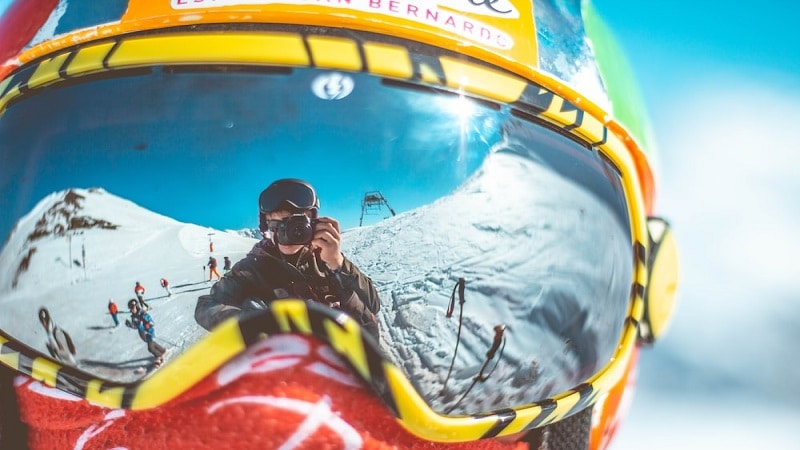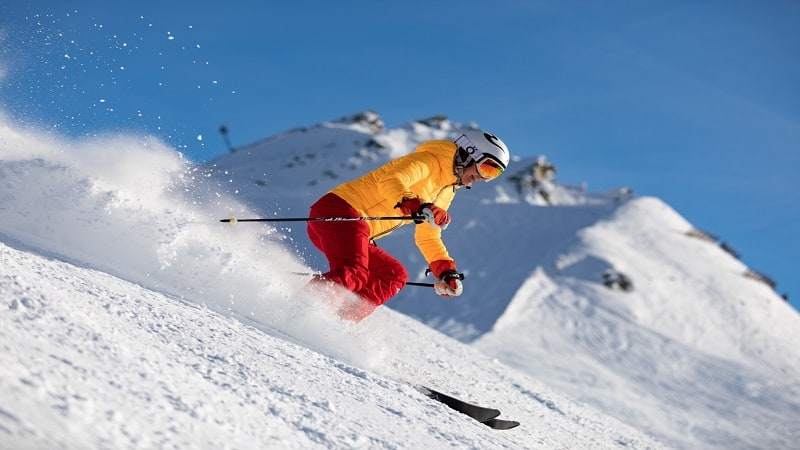If you love skiing and can’t wait to hit the slopes again this winter, you must know about the different types of snow that may affect your activity and involve different risks. Sliding down a slope after a heavy snowfall isn’t the same as skiing on the similar one at the end of a clear day. Your practice may turn out to be more or less safe and enjoyable due to the consistency and texture of the snow. Therefore, the idea should be to look for the best snow conditions for skiing. But how do you find which snow is the best? Don’t worry! This article intends to discuss in depth the different types of snow, their texture, and consistency and the risks they involve to help you choose the type you must look for before heading off to skiing, especially if you’re planning to hit steeper slopes.
So, if you want to continue to enjoy your ski days without ending up drained or injuring yourself, and above all, take advantage of the snow at its best, read on carefully!
Types of Snow: Find the One that Suits Your Skiing Level
Several factors influence the type of snow that a skier should look for. The major determining factor is the weather condition on the days you want to go skiing. If it snowed too much a day before you planned to hit the slopes, or if the weather is too rough, you would want to hold your plan to avoid risks. Your ski resort’s location from the sea is also a big determining factor since it makes the snow wetter or drier.
1. Powder Snow, the Best One for Skiing
Powder snow is the ‘creme de la creme,’ the best of its kind and the most common type. It is the snow type with a fluffy appearance, like cotton candy and is best to learn to ski. Thus, it is the most desirable snow for skiers of all levels, especially amateurs with little experience.
Also known as sugar snow, you can find powder snow if it snowed recently and in large quantities. Its texture is very loose, allowing skiers to slide easily without losing their balance with less strong impacts. Falls in such snow do not result in injuries as the embrace of the snow cushions you.
How do you recognize if it’s powder snow? It’s very easy to know if the snow is powder or not. When you walk through it or try to slide, you find it very fluffy, forming a cloud around you. It’s the same snow that you love making snowmen with. However, you need to be careful since too much snowfall (more than 30 centimeters) increases the risks of avalanches. In that case, do not head off to slopes alone without taking the right precautions specified by the ski resort.
So if you’re a beginner or want to enjoy better-controlled skiing, this is the type of snow you should look for. Select a ski resort that has this type of snow. For many skiers, beginners and professionals, this is the best type of snow for skiing with the least risks of injury.
Hard Snow
The hard snow, also known as icy snow, as its name indicates, is tougher snow that is frozen. Although it involves many risks and is dangerous to ski on, advanced or experienced skiers often opt for this type of snow for a more thrilling venture. However, to ski on hard snow, you must have enough skiing experience as a skier gets maximum speed on the descents when the snow is hard. It is the snow type that beginners fear the most. On the other hand, it may be helpful for beginners to learn how to halt or break the speed without falling.
Hard snow is the result of not having snow for a long time. New layers are not created when it doesn’t snow for a long time, and the old ones keep on melting during the daytime and freeze at night, making it icy and hard. Skis glide faster on hard snow, making it challenging for skiers. One must be fully prepared and cautious to try skiing on it since it is difficult to control the skis and falls are riskier. By just walking on it, you can feel that it’s hard snow under your feet.
Powder-Hard Snow
As the name indicates, Powder-hard snow is a combination of both types of snow where the base is compact with a layer of 5 to 10 centimeters of powder snow on it. This is the most common type comprising both frozen parts and fluffy snow. The base is compact because the machines clear powder snow, and the snowfall cover them with fine snow. It is also considered a perfect snow type by many skiers as it has a consistent base.
But how do you recognize that it’s not powder snow? Well, the best way is to recognize during the daytime, ideally late afternoon, when many skiers have already skidded through the slopes, and you can see the frozen base and finer snow. It is also ideal for skiing and even more favorable for some as it enables them to slide down the slope with ease with the more controlling technique.
Wet Snow
Wet snow appears after rain or during the afternoon due to increased temperatures that melt the snow into liquid. This is difficult snow to ski because the loss of density increases the risk of skis getting stuck in the snow and falling. Beginners can find it difficult to ski on such snow since the skiing techniques usually do not work on it. In addition, dense slopes are always dangerous for beginners. There are more chances of driving skis right into the wet snow when trying to brake. However, you can prevent this by maintaining your speed and avoiding going fast.
Spring Snow
This type of snow doesn’t need much discussion because you must be familiar with it if you’re into skiing. As its name indicates, it appears in spring when days are longer, and the temperature is higher. This type of snow is also soft and very fluffy in appearance. Skiing on this type is more demanding. If you’re planning to ski during spring, we recommend starting skiing early in the morning before the temperature rises.
What Types of Snow Skiers Look for?
Skiers always look for either powder snow or spring snow. Now that we have discussed each type of snow, its texture and other features in detail, let’s discuss some tips to help you determine the right one for you. If you’ve chosen a very busy route, you need to get up early to make the first traces. You shouldn’t be swayed by the landscape only and learn about the risks involved.
If you’re a beginner or do only a few days of mechanical skiing, the powder is the right snow for you. The steeper the slope, the difficult it is to ski with powder snow (more than thirty degrees).
The best is to look for ultra-light powder on an average thickness as it doesn’t require much effort. Beginners can enjoy the descent with skis of medium width. However, sometimes, powder snow can be stable even on steeper slopes. This can be the case when the snow is homogeneous and falls without wind. But, these are rare conditions. Do not ski the next day if it snowed all night as a rule of thumb, as the snow will be quite dense the next day.
If the snow has undergone several cycles of thaw/refreeze transformation, the snowflakes take the form of pointed stars, round grains, well clumped together. They form a hard uniform coat, both unpleasant to ski and dangerous. The idea with hard snow is to attack the descent when the thaw is sufficient to make it as easy as a groomed ski slope.
Sometimes it won’t be easy to get these conditions on the mountains, depending on the route length and the orientations of the different slopes. In these cases, always prioritize safety by skiing the steepest slopes in the best possible conditions.
Skis function differently on different types of snow. With wide skis, you can ski with your legs well bent in the tongue but without tilting your torso too much forward. With narrower skis, the lift is limited, and there is a tendency to ski with the heel resting to allow better lift-off of the tip. A good technical background can correct it by keeping the tibial support and working vertically with support at the bottom of the snow.
In general, many skis lack frontal support. This is partly due to ski boots, which often remain a bit flexible and an easily accessible technique. Less aesthetic, this position remains, however, very effective and balanced.
Sporten Stringer Fun Carver 39 ” Ski Blades (ASIN# B08NWB922B) is a good choice. If you’re a beginner, you can choose Lucky bums Heirloom Skis with wooden bindings (ASIN# B004GOLG1S).
The Best Snow Conditions for Skiing
Mainstream media
Although media is not dedicated to mountain weather, it is still a source of information that requires a minimum effort to consult. If you’re a skiing enthusiast, you need to learn to read between the lines. No weather website is 100% accurate. However, some retain a more scientific vocation and remain a fairly reliable source of information. In addition, written bulletins are issued at fixed times.
Specialized Media
Some media are dedicated to snow forecasts. It makes it easy to visualize where the models predict snow. They also offer detailed forecasts for several ski resorts and can be effective tools for closely following a particular ski resort. However, when you are in the backcountry, you have to consider more information than just the amount of snow and the direction of the winds.
Some Additional Tips
Now that you think you’ve found the best place to ski and the best snow conditions, here are some mistakes we’ve all run into and some tips to avoid them:
- Don’t underestimate the traffic. If the storm has been forecast for seven days and the media is talking about it, it might not be a good idea to hope for some powder upon arriving at the resort. It is better to consider the traffic as well if you’re looking for powder snow.
- It is always necessary to take into account the wind direction. Going out into alpine terrain has become a reflex to avoid drama, but the wind can also negatively or positively affect the terrain.
- Watch out for inversions. Forecasts do not provide this information, but they are relatively easy to see. If it is -5 at sea level and 3 degrees at 1500m altitude, even though snow forecasts predict 30cm of snow, it is likely to receive sleet or freezing rain at 500m altitudes.
- Use historical snowfall and temperature data sources. However, be careful the station readings are not standardized. Each station has its process!
- Some professional or amateur meteorologists maintain social media pages or localized bulletins. Consult them as needed.
- Weather radar maps and satellite images also make it possible to verify that the predictions are still valid.
Our Final Thoughts
We hope the information above has answered the question, how to find the best snow conditions for skiing? Now that you know the different snow types, their uniformity and texture and the risks they involve, it will be easier for you to choose the right snow conditions and enjoy the maximum.
Do not forget to share this with your skier friends and let them know about the different types of snow they can find in the alps and which ones are the most suitable to enjoy skiing!

















